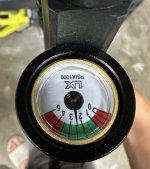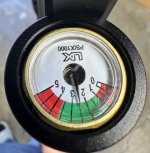Has anybody had their notos apart to let me know easiest way to fix this leak.

You are using an out of date browser. It may not display this or other websites correctly.
You should upgrade or use an alternative browser.
You should upgrade or use an alternative browser.
Notos leak
- Thread starter Rawroots
- Start date
I had the PP700 leak the same place. Degas, or let it leak down to 0. Unscrew it and replace O ring.
Upvote 0
While you have the cylinder degassed, might as well unscrew the other end and replace the O-ring on the fill port screw with a -008 in 90 durometer. It’s a common source of leaks going back several years, and a recent thread called my attention to it still being a weak point.
Upvote 0
Yes thank you for that, 2 days ago i polished the seating area for that o-ring , also removed loose chips bottom of thread area on fill port screw. Probably left behind from tapping those threads.While you have the cylinder degassed, might as well unscrew the other end and replace the O-ring on the fill port screw with a -008 in 90 durometer. It’s a common source of leaks going back several years, and a recent thread called my attention to it still being a weak point.
Upvote 0
Has anybody had their notos apart to let me know easiest way to fix this leak.
View attachment 372443
O-ring.
Upvote 0
Hmm, My notos starts to leak recently, Haven't checked where the leak is from yet.
BTW, you can check this video about teardown, it is super helpful.
BTW, you can check this video about teardown, it is super helpful.
Upvote 0
Located the leak of my Notos, front the filling port region, however, it isn't clear whether it is from filling port or the gauge.
I'll leave it for now, given the leak is currently small

I'll leave it for now, given the leak is currently small
Upvote 0
The fill port O-ring is a longstanding weakness of SPA PCPs. A -008 in 90 durometer will last longer than the OEM one.
Upvote 0
You are right!The fill port O-ring is a longstanding weakness of SPA PCPs. A -008 in 90 durometer will last longer than the OEM one.
Today I decided to open the tube and check the leak, since all air leaked overnight.
Quickly observed the issue on the fill port O-Ring, the screw was tighten too much causing the O-Ring was flatten, plus observed a significant dent at the body of the O-Ring. Replaced with a new O-Ring and we'll see whether it can hold the pressure overnight.
The O-Ring was damaged:
I don't have the exact replacement O-Ring for it, but luckily I found a O-Ring in a very similar size that came with the hand-pump, I was able to put it in and so far looks well.
For people not familiar where the O-RING is,
Upvote 0
Nice, glad to hear you were able to get it repaired. For what it's worth, the O-ring fails not due to fastener torque but due to extrusion, which is why a 90 durometer lasts much longer than the softer OEM O-ring.
Upvote 0
I actually wasn't sure what was "90 durometer" and I just googled itNice, glad to hear you were able to get it repaired. For what it's worth, the O-ring fails not due to fastener torque but due to extrusion, which is why a 90 durometer lasts much longer than the softer OEM O-ring.
That is interesting though, so you mean the "dent" I marked out above, was likely caused by the extrusion when filling the air?
BTW, when assembling it back, I tightened the screw till it barely touches the O ring(To the point you start feel the torque), it does make it much easier to fill the air, previously there was a bit spongy feeling when filling the air, I could clearly feel that I had to fight against something in order to push the air in, now that goes away.
Upvote 0
Hard to say with certainty but the source of the leak was likely unrelated to the dent observed on the face of the O-ring, but rather due the thinned out material on the O-ring's inside diameter.
Meanwhile it is true that the screw need only be threaded in until the head is just beginning to squeeze the O-ring. The pressure differential created by purging the line after filling causes the O-ring to compress and seal off.
Meanwhile it is true that the screw need only be threaded in until the head is just beginning to squeeze the O-ring. The pressure differential created by purging the line after filling causes the O-ring to compress and seal off.
Upvote 0
I must replace those o-rings several times a year on mine Spa pcp's
Always have those in stock.
Always have those in stock.
Upvote 0
Good to know, I was a bit disappointed that the OEM only lasted a month and half. Now I replaced it, fastened the screw correctly(barely touching the ORING), and see how long it gonna holdI must replace those o-rings several times a year on mine Spa pcp's
Always have those in stock.
Upvote 0

